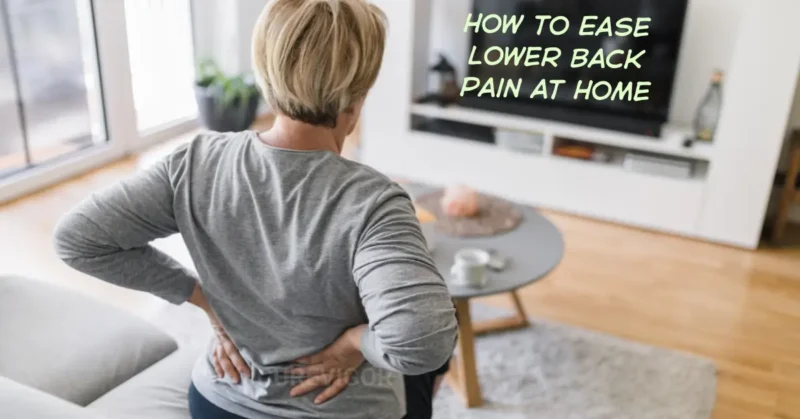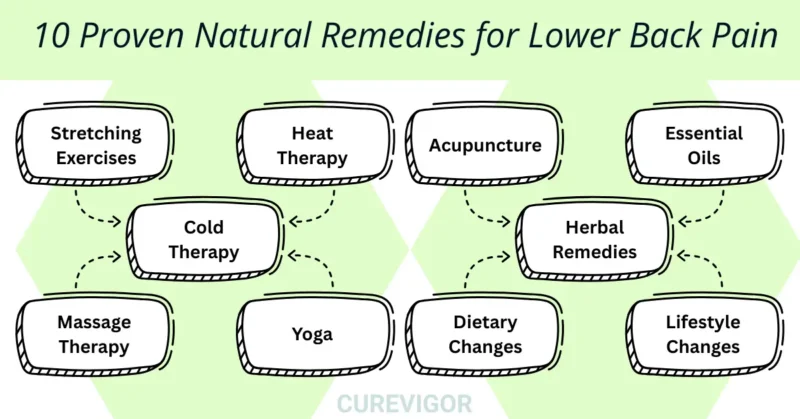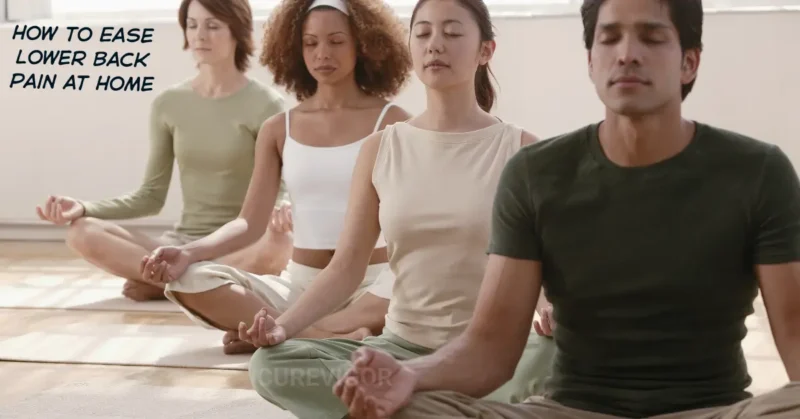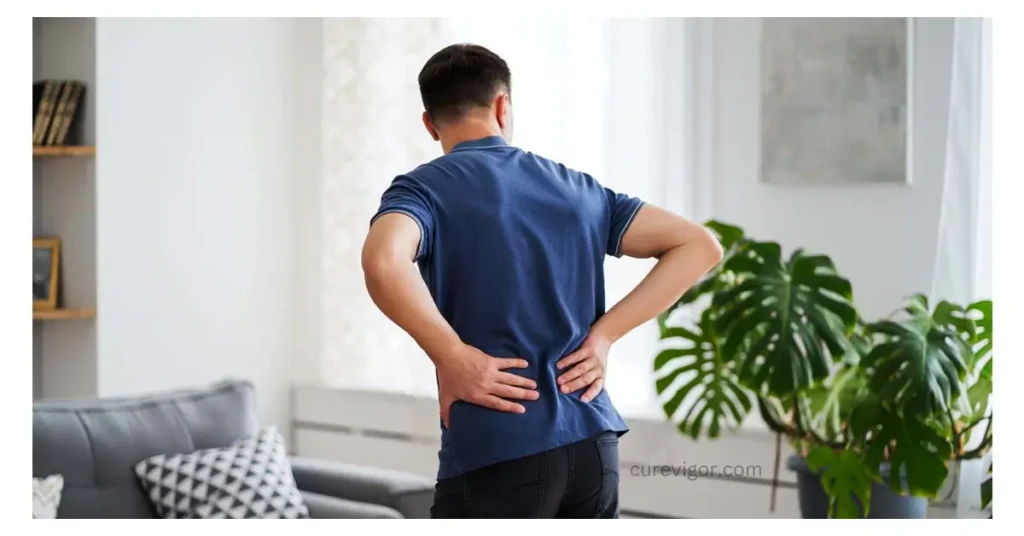Learn how to ease lower back pain with 10 proven home remedies—including stretching, yoga, massage, and lifestyle changes—that provide safe and lasting lower back pain relief without medication.
Thank you for reading this post, don't forget to subscribe!Low back pain affects millions worldwide, often caused by muscle strain, poor posture, a sedentary lifestyle, or a herniated disc. Simple remedies can help, but if pain persists, professional medical advice is necessary.
How to Ease Lower Back Pain at Home Naturally
Many seek natural ways to ease lower back pain at home, and there are remedies that truly help. Lower back pain is widespread, disrupting comfort, sleep, and daily activities. While medication and surgery are sometimes required, many cases improve with natural methods you can use at home.
Fortunately, you don’t have to rely only on painkillers or invasive procedures. Natural remedies can offer lasting relief and support your overall well-being. Let’s review 10 proven options for alleviating lower back pain naturally at home.

Understanding How to Ease Lower Back Pain Naturally
Causes of Lower Back Pain
- Muscle Strain: Sudden movements, heavy lifting, or repetitive motions often strain the muscles and ligaments in the lower back, leading to sharp or lingering pain.
- Poor Posture: Hours of slouching at a desk, looking down at a phone, or standing incorrectly can put unnecessary stress on your spine. Over time, poor posture is one of the most overlooked triggers of chronic back pain.
- Underlying Medical Conditions: Conditions such as arthritis, herniated discs, or osteoporosis can also contribute to ongoing discomfort in the lower back.
The Importance of Natural Remedies in Learning How to Ease Lower Back Pain
- Avoiding Medication Side Effects: Painkillers may offer short-term relief, but relying on them for the long term can lead to unwanted side effects such as stomach issues, dependence, or fatigue.
- Holistic Approach: A well-rounded, natural approach doesn’t just mask the pain—it strengthens your body, improves mobility, and supports overall health.
10 Proven Natural Remedies for Lower Back Pain

1. Stretching Exercises
Benefits of Stretching: Daily stretching is one of the most straightforward yet most powerful methods when exploring how to ease lower back pain naturally at home.
It relaxes tight muscles, improves spinal flexibility, and enhances blood flow, which speeds up recovery. Stretching also strengthens the supporting muscles around your spine, helping to prevent future injuries.
Recommended Stretches: Start with the cat-cow stretch, which gently mobilizes your spine. Follow with the knee-to-chest stretch to ease tension in your lower back muscles.
The child’s pose helps elongate the spine and relieve compression. For best results, perform each stretch slowly, holding for 20–30 seconds.
2. Heat Therapy
Benefits of Heat Therapy: Heat therapy is a trusted technique in how to ease lower back pain quickly. Heat works by dilating blood vessels, improving oxygen flow to the affected muscles, and reducing stiffness.
It’s particularly effective for chronic lower back pain or tightness caused by poor posture.
How to Apply Heat Therapy: Make use of a hot water bottle, a heating pad, or a heated towel. Apply for 15–20 minutes, up to three times daily.
If you don’t have equipment, a warm bath or shower also works wonders. Always keep the temperature moderate to avoid burns.
3. Cold Therapy
Benefits of Cold Therapy: Cold therapy is most effective in the first 48 hours after an injury. It reduces swelling, numbs sharp pain, and helps prevent tissue damage. Ice therapy is ideal for sudden strains, sprains, or flare-ups.
How to Apply Cold Therapy: For ten to fifteen minutes, place an ice pack or a bag of frozen peas covered with a small cloth over the hurting spot. As needed, repeat every two to three hours. Frostbite can result from applying ice directly to the skin.
4. Massage Therapy
Benefits of Massage Therapy: Massage improves circulation, reduces muscle tension, and promotes relaxation. It can break up knots and scar tissue that often form in the lower back after repeated strain.
Types of Massage: A deep tissue massage targets stubborn knots, while a Swedish massage focuses on relaxation and improved circulation. For self-care, use a foam roller or a tennis ball against the wall to gently massage sore spots.
5. Yoga
Benefits of Yoga: Yoga is not just exercise—it’s a holistic way to discover how to ease lower back pain while improving flexibility. Yoga offers both physical and mental benefits.

It enhances posture, strengthens the core muscles that support the spine, and lowers stress, which is sometimes disregarded as a cause of lower back discomfort.
Recommended Yoga Poses: Try the downward-facing dog to stretch the hamstrings and spine, the sphinx pose for gentle back extension, and the bridge pose to strengthen your glutes and lower back. Practice 2–3 times a week for long-term relief.
6. Acupuncture
Benefits of Acupuncture: This ancient therapy stimulates nerve-rich areas of the skin, releasing endorphins and reducing inflammation. Studies show acupuncture can provide significant relief for chronic back pain without side effects.
How Acupuncture Works: Thin, sterile needles are inserted into specific pressure points along energy pathways. This balances your body’s natural energy (Qi) and promotes healing. Sessions are usually painless and may provide lasting relief after several treatments.
7. Herbal Remedies
Benefits of Herbal Remedies: Herbs are nature’s medicine cabinet. Many contain anti-inflammatory compounds that work similarly to painkillers but without harmful side effects.
Recommended Herbs:
- Turmeric: Contains curcumin, a powerful anti-inflammatory compound.
- Ginger: Reduces muscle soreness and inflammation.
- Devil’s Claw: Used traditionally to ease arthritis and back pain.
- Drink as teas, add to meals, or take supplements (with medical guidance).
8. Essential Oils
Benefits of Essential Oils: By relaxing the nervous system and releasing tense muscles, aromatherapy and topical treatments help people manage their pain.
Recommended Essential Oils:
- Peppermint oil: Provides a cooling, pain-relieving effect.
- Lavender oil: Calms the mind and relaxes tense muscles.
- Eucalyptus oil: Acts as an anti-inflammatory and helps improve circulation.
- Before applying to the lower back, combine two to three drops with a carrier oil such as coconut oil.
9. Dietary Changes
Benefits of Dietary Changes: What you eat plays a big role in inflammation and muscle health.
An anti-inflammatory diet can reduce chronic pain, while proper nutrients strengthen bones and muscles.
Recommended Foods:
- Leafy greens that are high in calcium and magnesium include kale and spinach.
- Fatty fish such as salmon, for omega-3s that fight inflammation.
- Berries and citrus fruits for antioxidants and vitamin C.
- Nuts and seeds for protein and good fats.
- Limit processed foods, sugar, and excess caffeine, which may worsen inflammation.
10. Lifestyle Changes
Benefits of Lifestyle Changes: Even small daily habits can make or break your spinal health. Long-term relief often requires consistent lifestyle adjustments.
Recommended Lifestyle Changes:
- Nuts and seeds for nutritious fats and protein.
- Take regular breaks from sitting—walk or stretch every 30 minutes.
- Use ergonomic chairs or standing desks to reduce strain.
- Incorporate low-impact exercise like walking, swimming, or cycling into your routine.
- Get enough sleep on a supportive mattress to allow your back to heal.
Conclusion: Your Next Step to a Pain-Free Back
If you’ve been wondering how to ease lower back pain without relying on heavy medications or expensive treatments, the answer lies in consistent, natural care.
Above 10 proven remedies—from stretching and yoga to herbal support and lifestyle changes—offer safe, effective, and lasting relief right from the comfort of your home.
The key is not to treat lower back pain as a one-time issue but as a signal from your body. By listening to it and applying a holistic approach, you not only reduce discomfort but also build a stronger, healthier spine for the future.
Start small—add gentle stretches to your morning routine, try heat therapy after a long day, or swap processed foods for anti-inflammatory meals. Over time, these small but powerful habits stack up to create meaningful, long-lasting relief.
Remember, learning how to ease lower back pain naturally is about more than comfort—it’s about reclaiming your mobility, energy, and quality of life. Take your next step today, and give your back the care it deserves.
Read more articles about Optimal Health Tips.
You might like to read:

